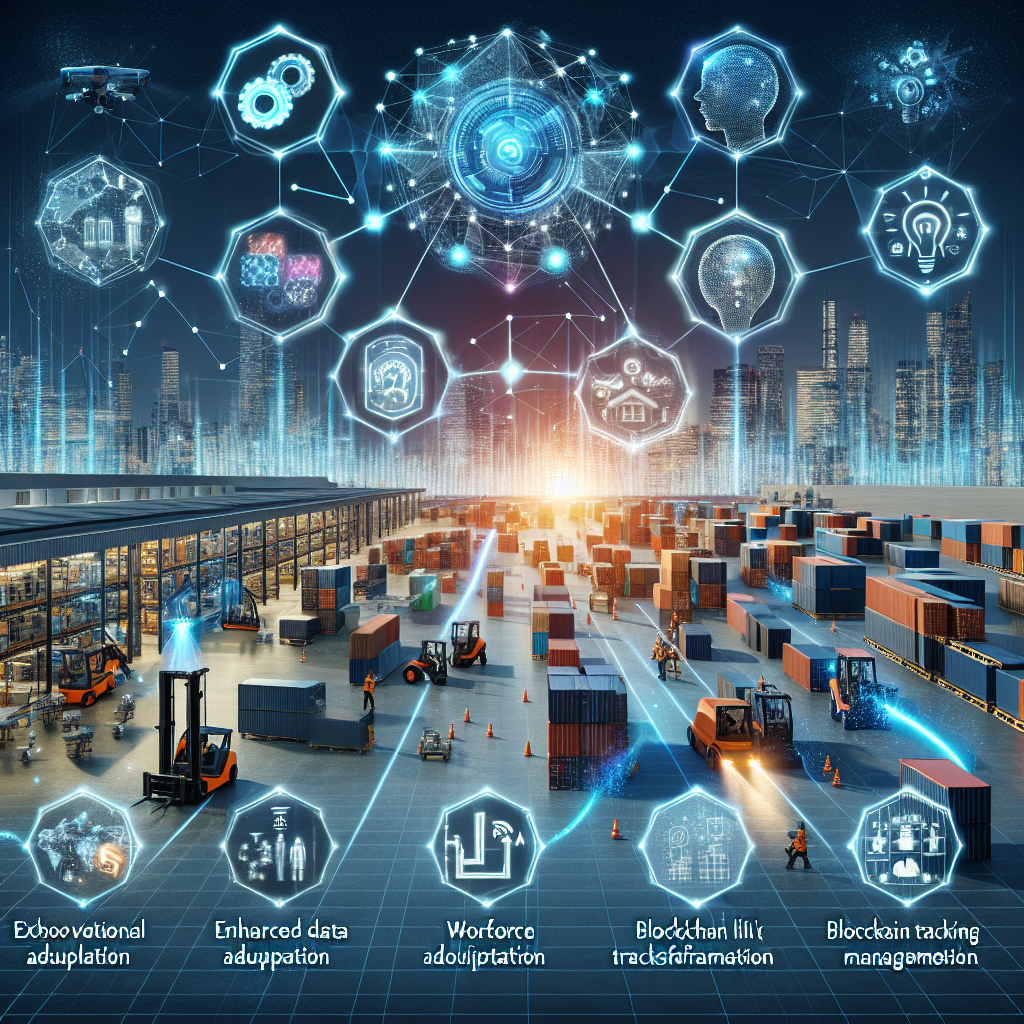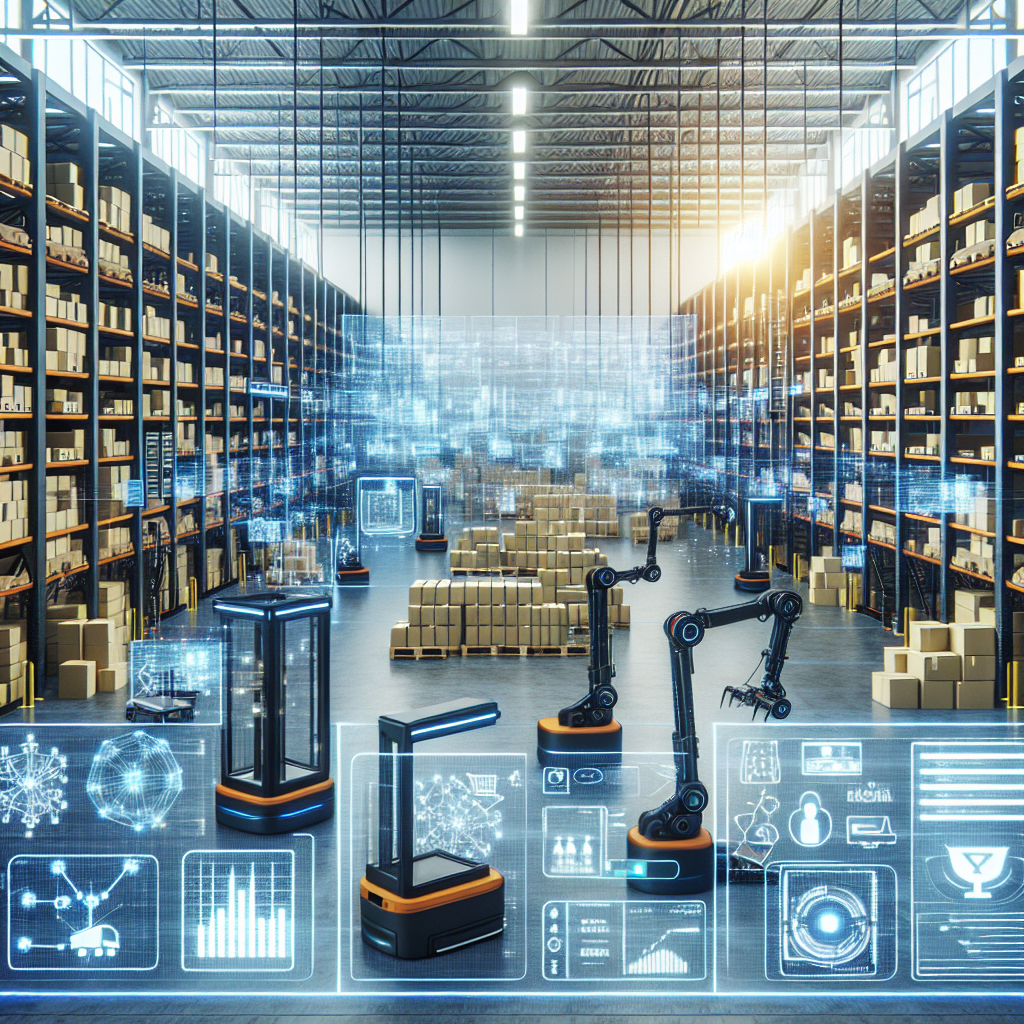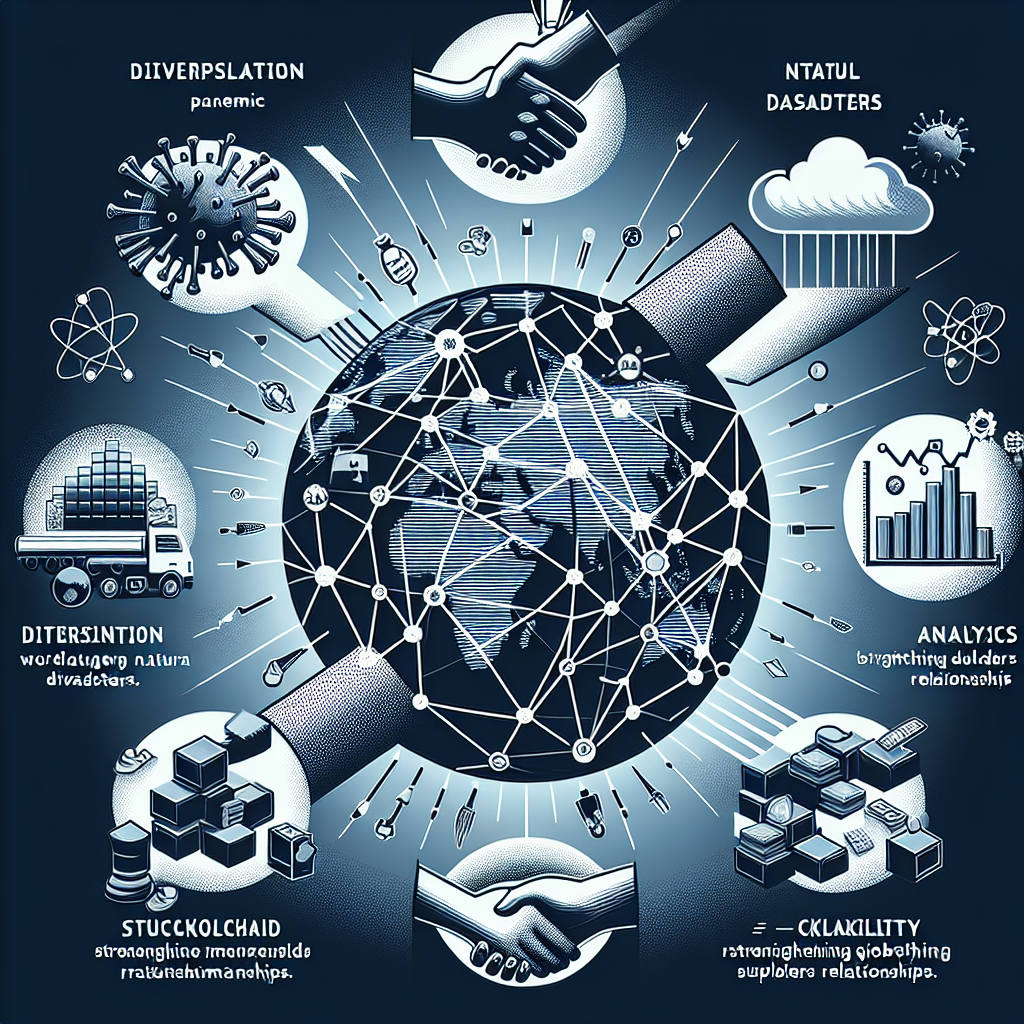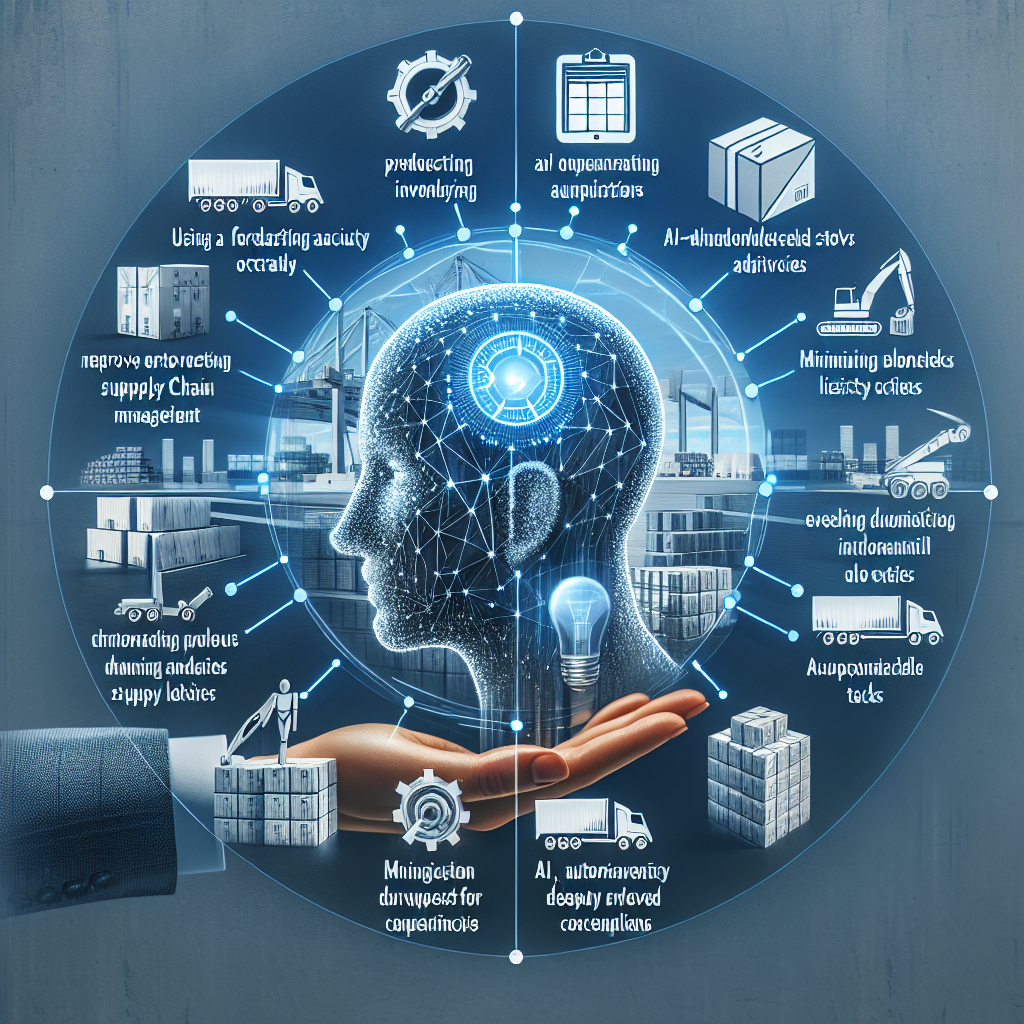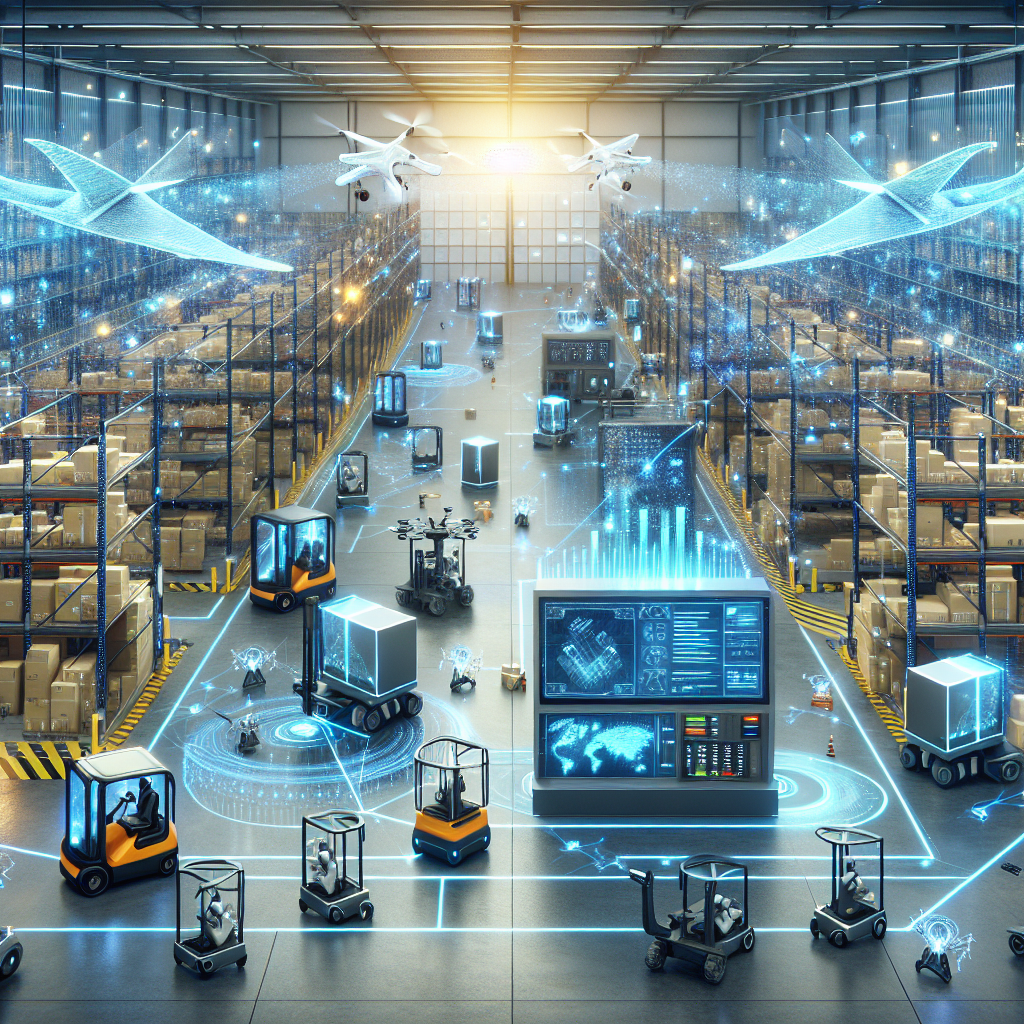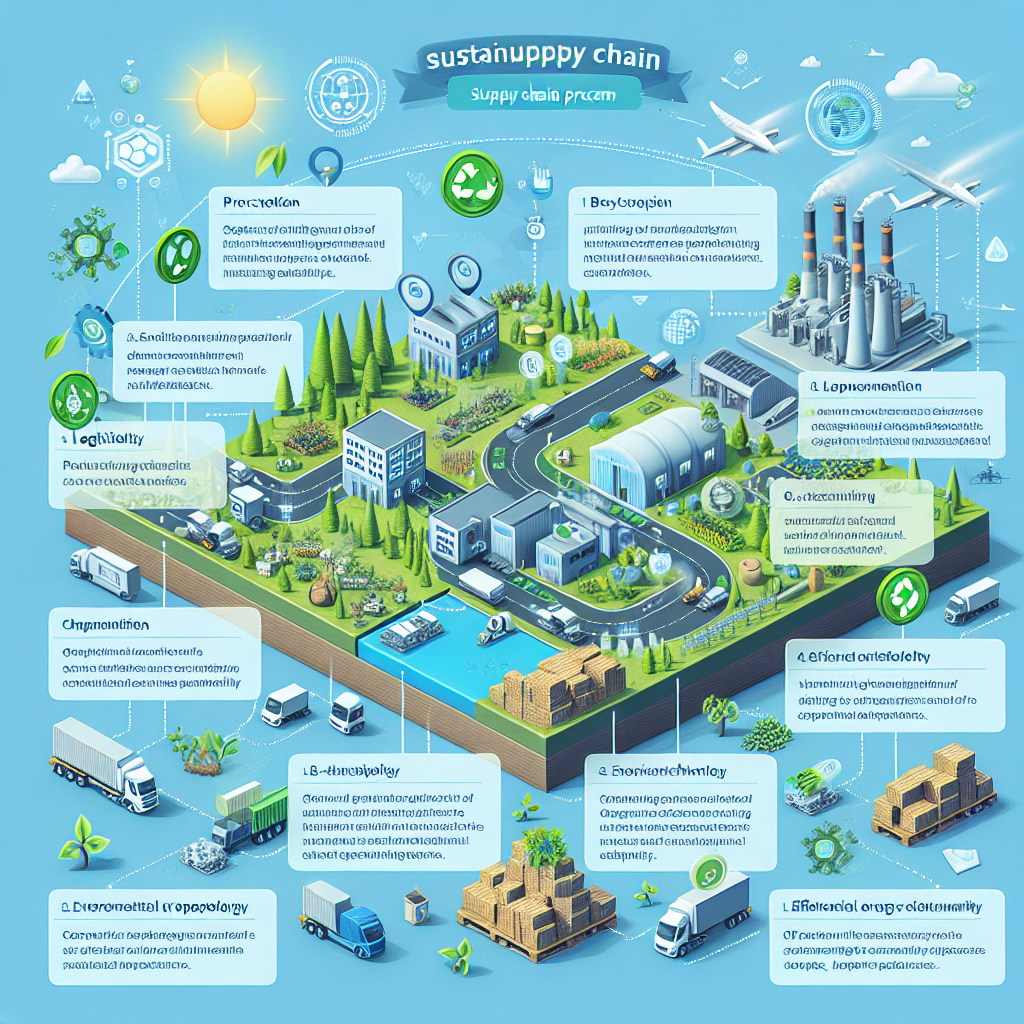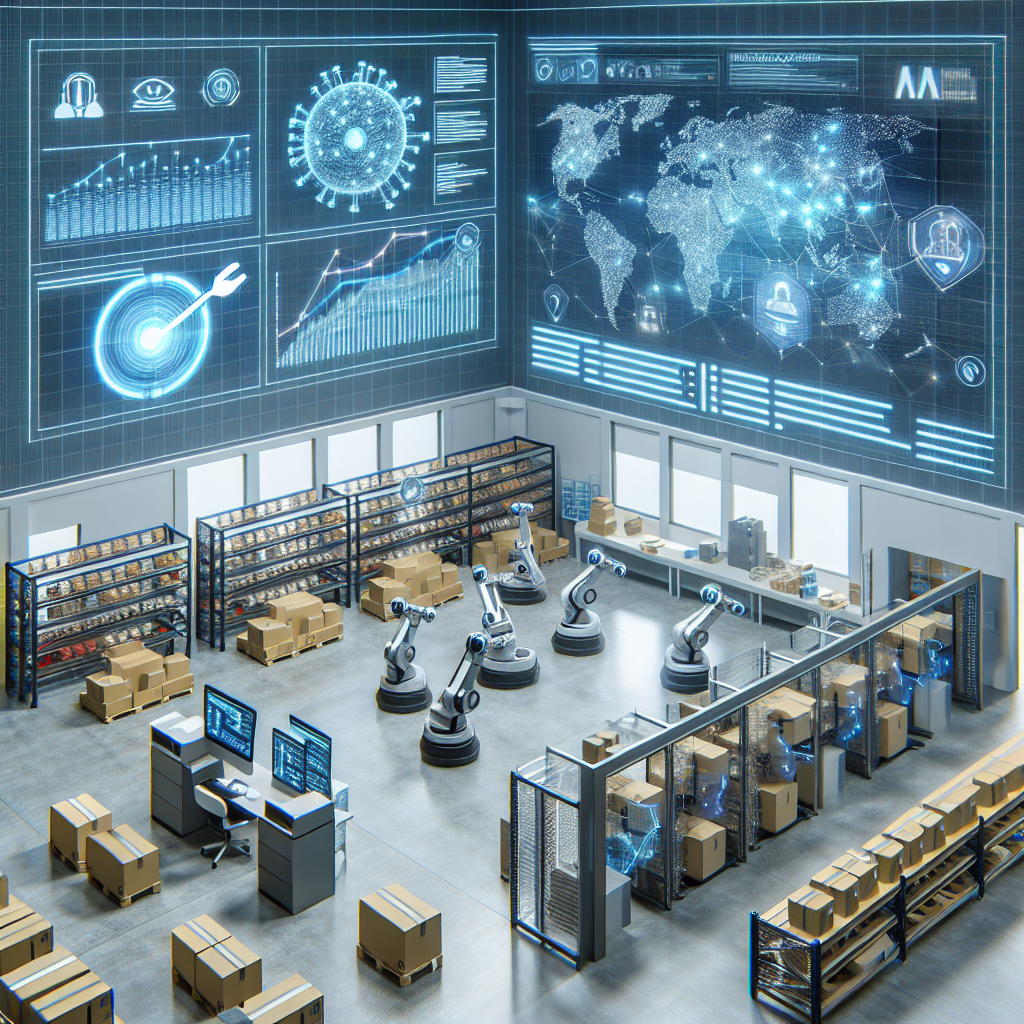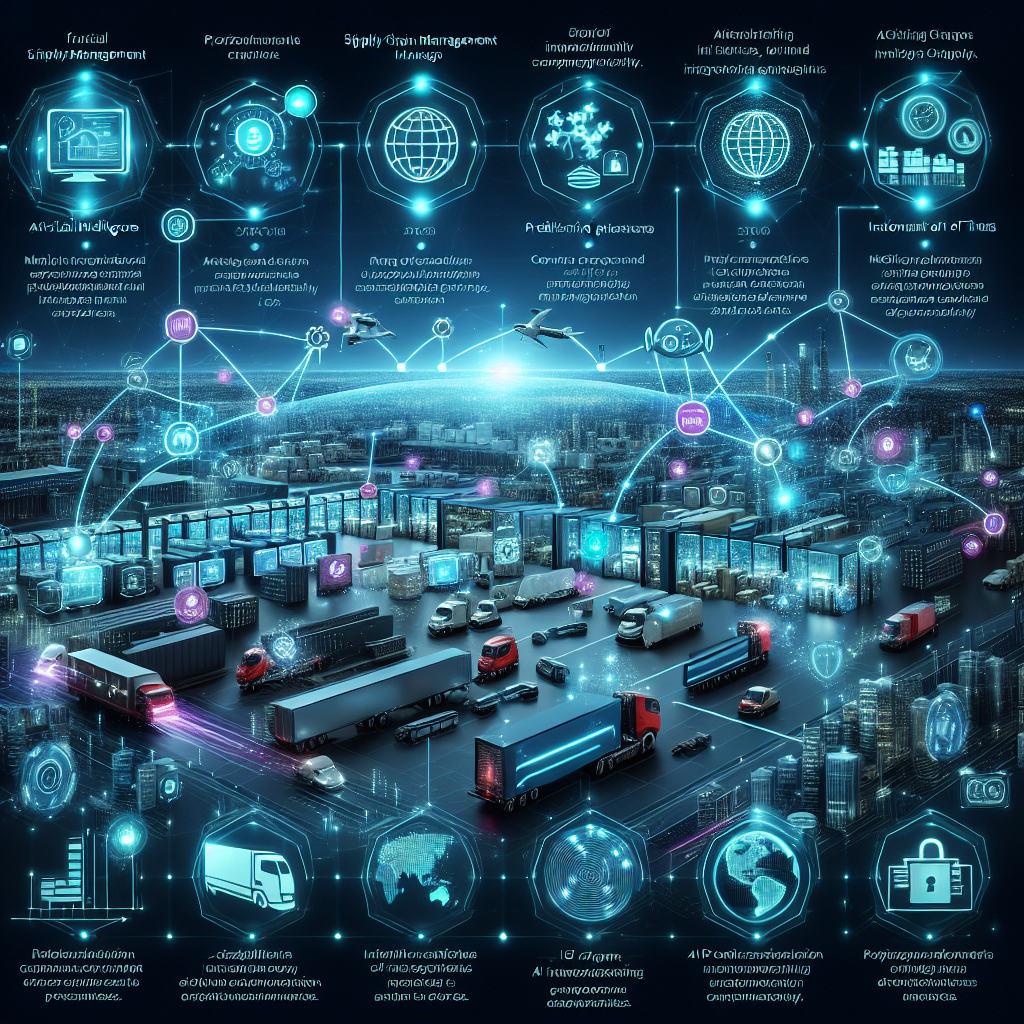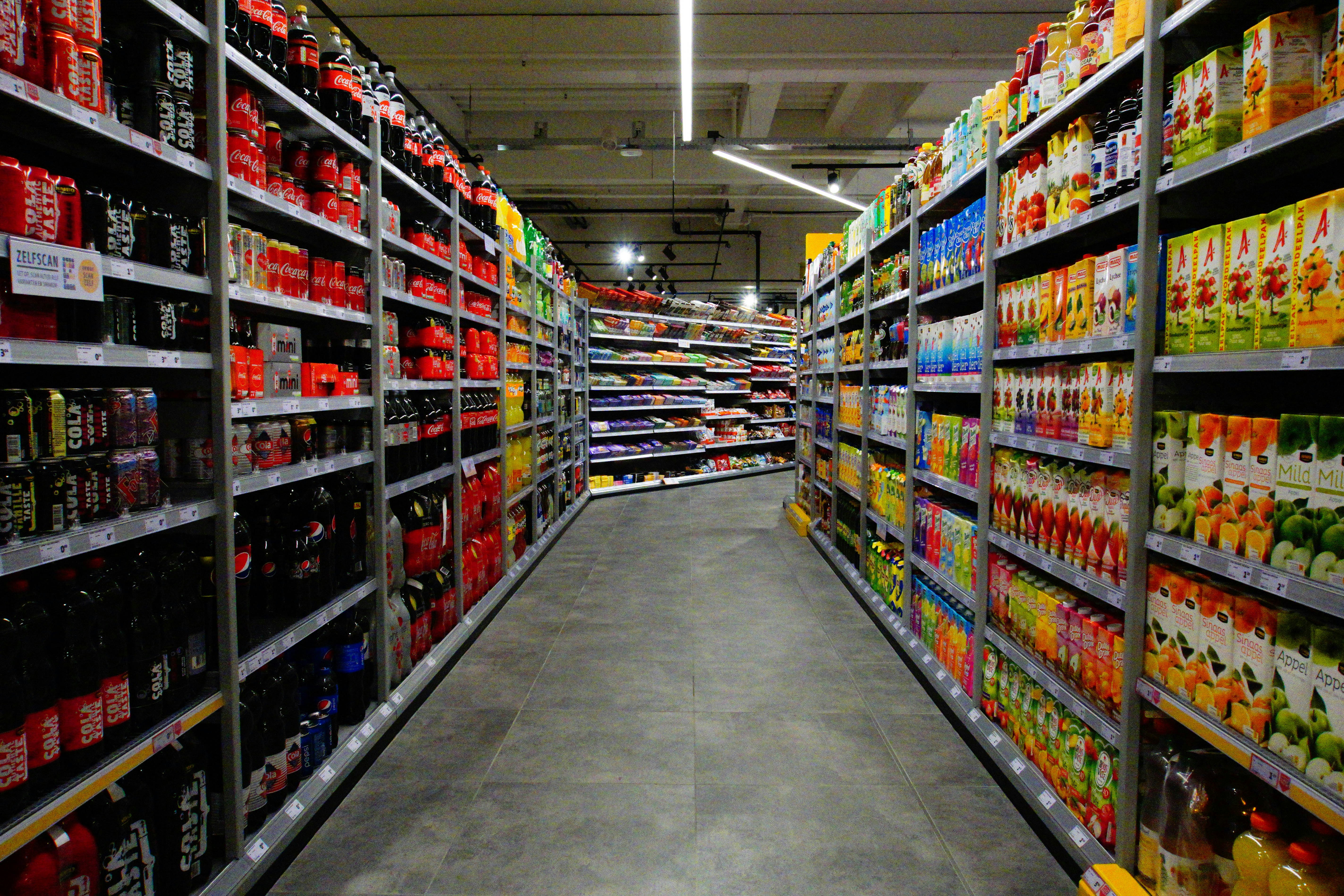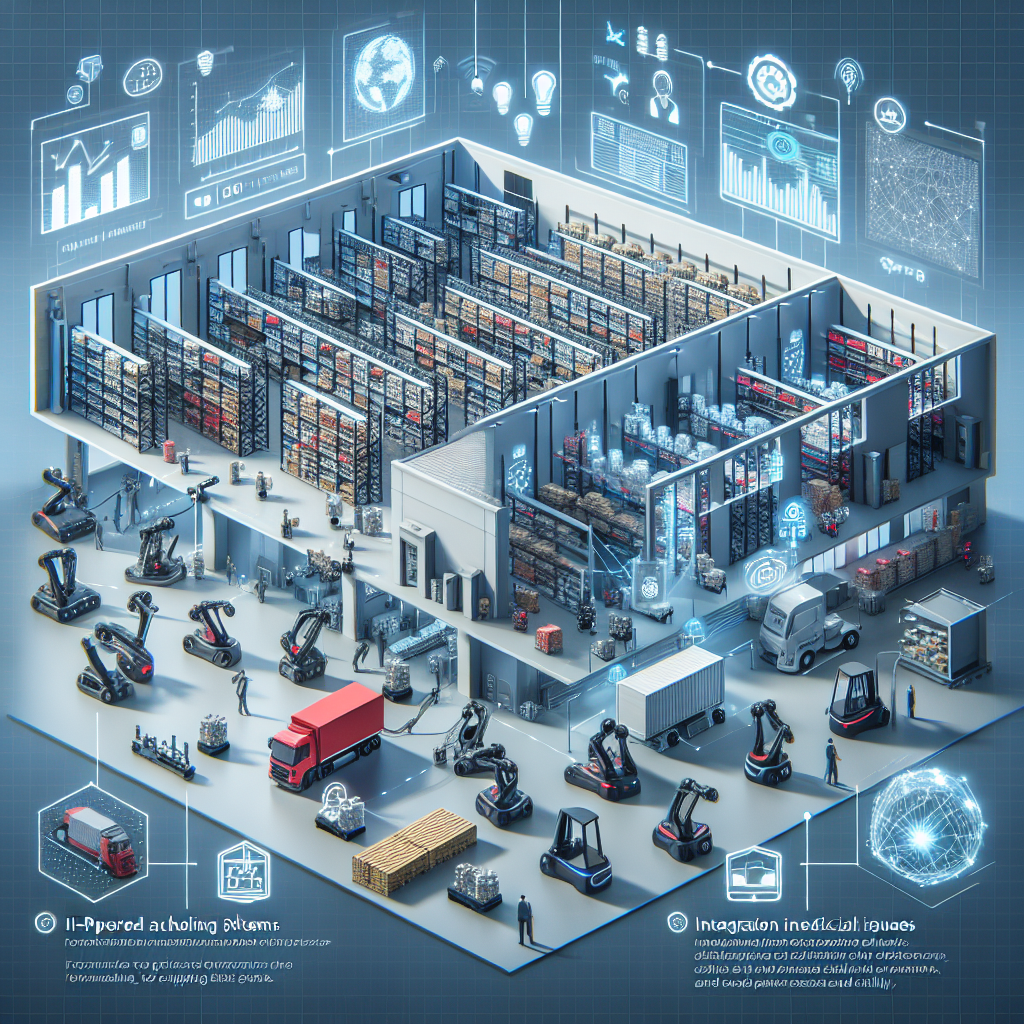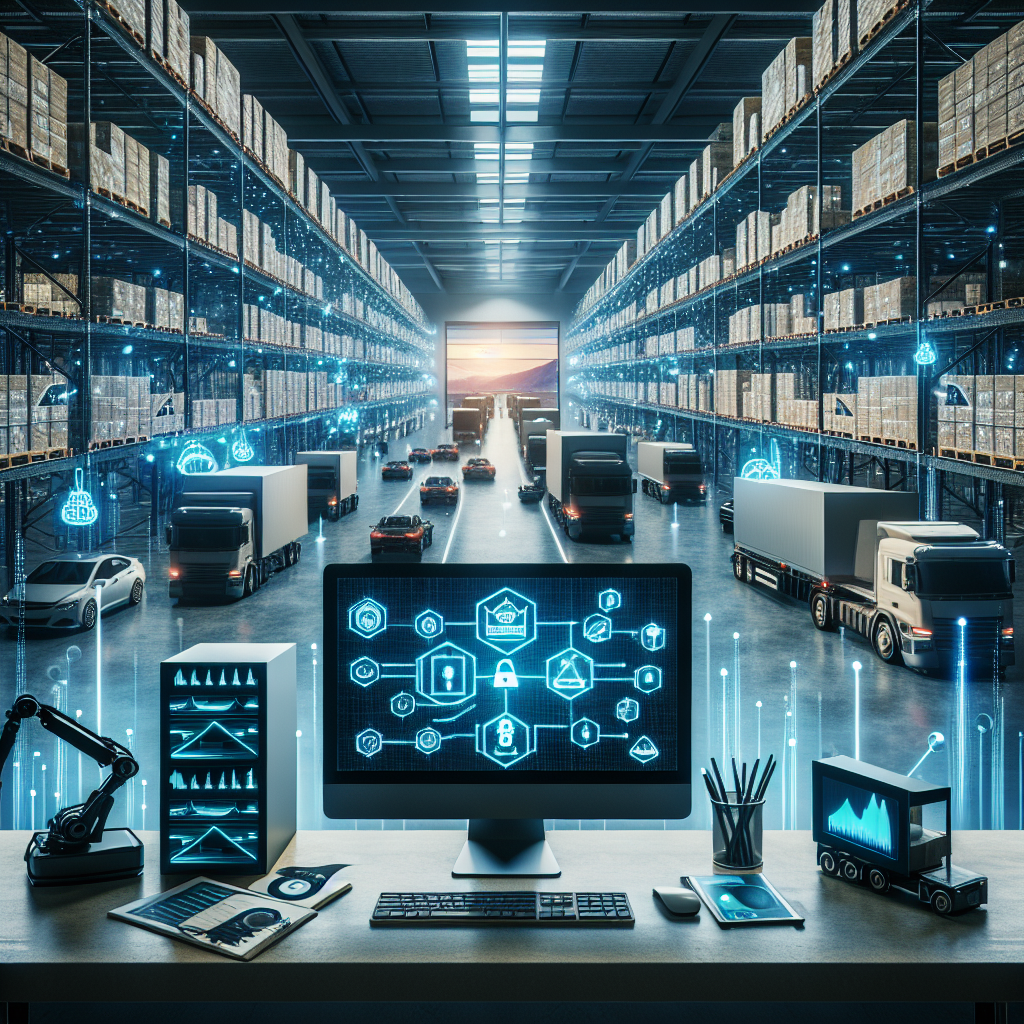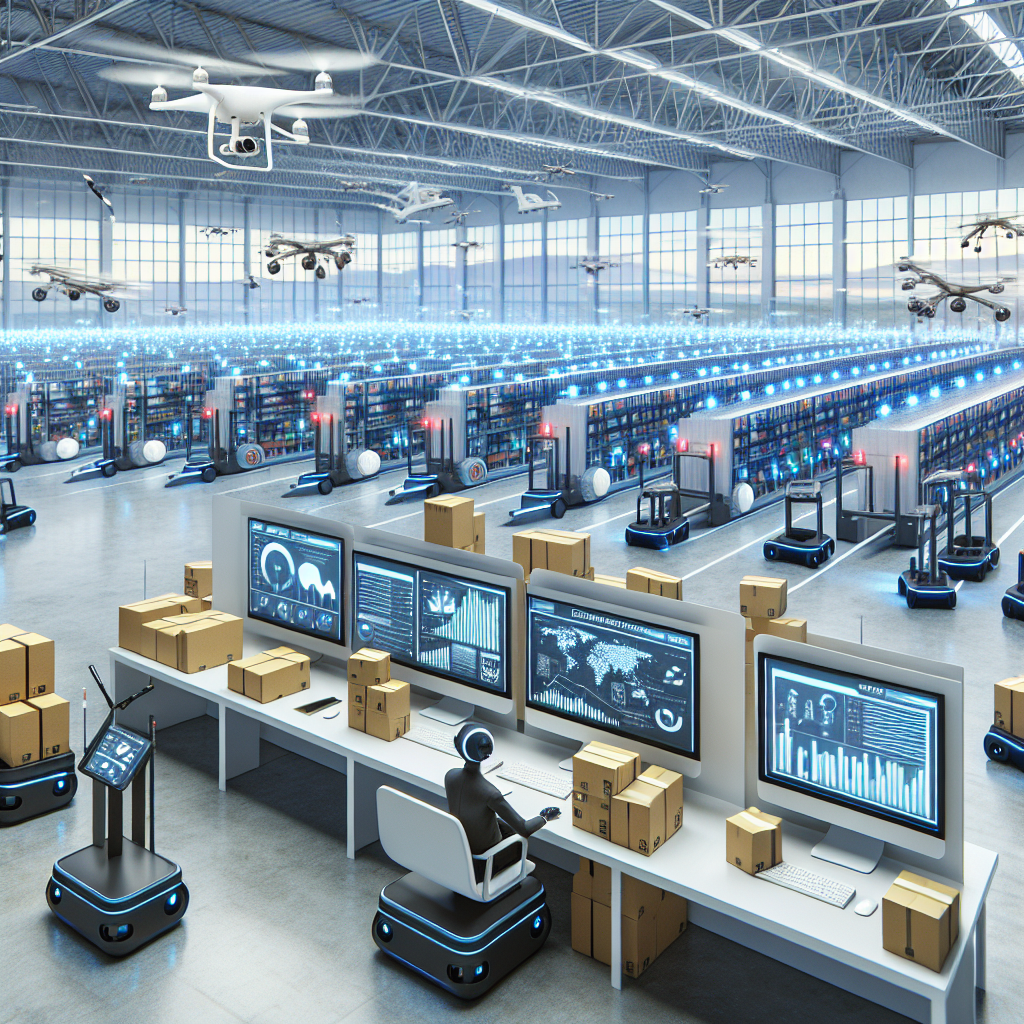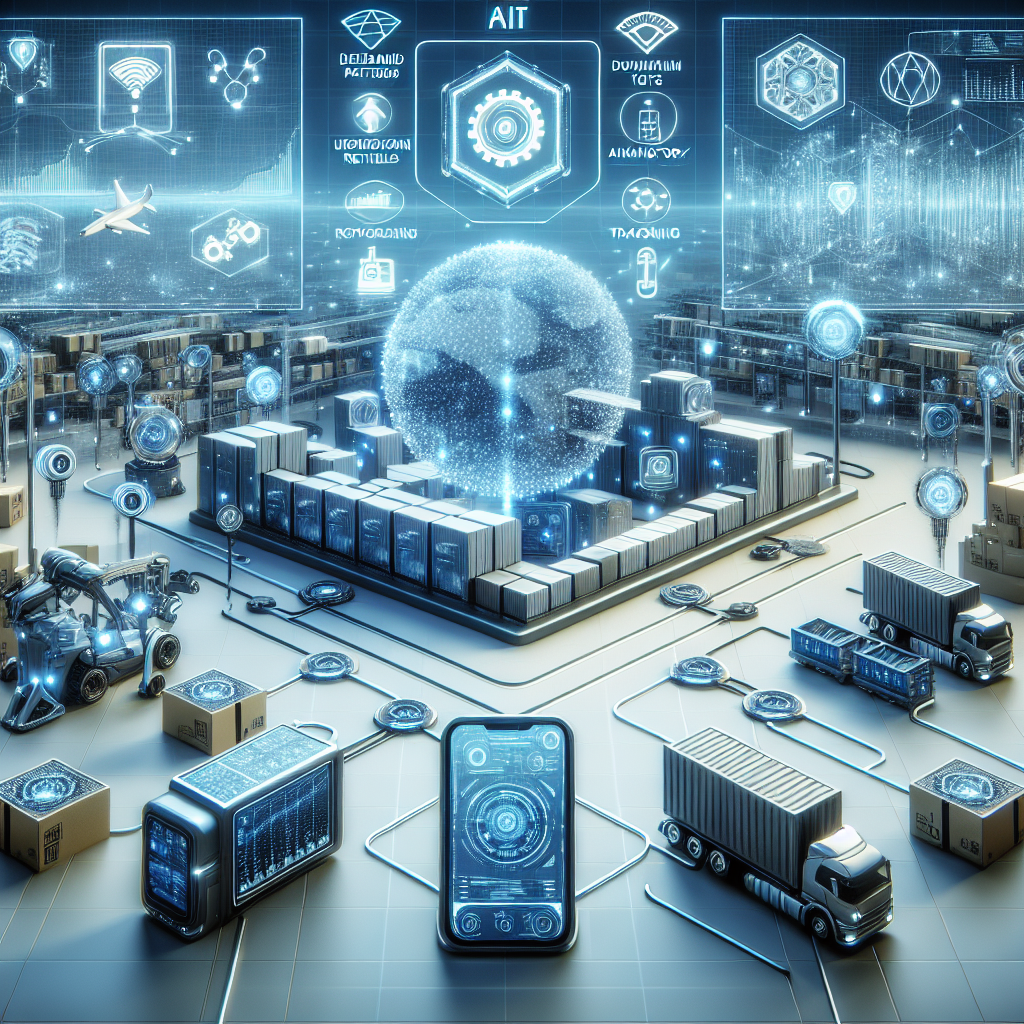Top News
Integration
Discover the transformative impact of Digital Twins on supply chain integration, improving efficiency and decision-making for businesses.
-
The Rise of AI-Driven Integration in Supply Chains
Sunday, 10 August 2025
-
Revolutionizing Supply Chains: The Impact of AI and IoT Integration
Sunday, 12 January 2025
-
Harnessing Blockchain for Transparent Supply Chain Management
Sunday, 05 January 2025
-
Revolutionizing Supply Chain Integration: Embracing Digital Twins
Monday, 28 October 2024
Retail
The global supply chain for food and agricultural products has become incredibly complex. As ingredients and products are sourced from all over the world, it can be difficult to track where something originated or how it moved through multiple stages of processing and distribution. This lack of transparency and traceability is a major challenge across the food industry. However, an emerging technology - blockchain - could transform traceability and trust in global food systems.
-
How Fashion can Tackle Growing Demands of a Stable and Agile Supply Chain
Monday, 18 September 2023
-
Circular Economy Needs To Factor In Clean Shipping
Monday, 15 May 2023
-
In Order to free up Shelf Space, Retailers are offering Black Friday Deals Today
Monday, 07 November 2022
-
Baby Formula is Latest Casualty of Supply Chain Crisis
Monday, 16 May 2022
Technology
Explore how blockchain technology is revolutionizing supply chains by enhancing transparency, reducing disputes, and streamlining operations. Learn about its benefits and challenges.
-
The Rise of Automation in Supply Chain Management: Embracing Technological Innovation
Sunday, 26 October 2025
-
Harnessing AI and Machine Learning to Revolutionize Supply Chain Management
Sunday, 26 October 2025
-
Automation in Supply Chain: Revolutionizing Efficiency with Cutting-edge Technology
Sunday, 12 October 2025
-
Embracing the Future: How Technology Transforms Supply Chain Operations
Sunday, 12 October 2025
Latest Developments in Sustainable Supply Chain Practices
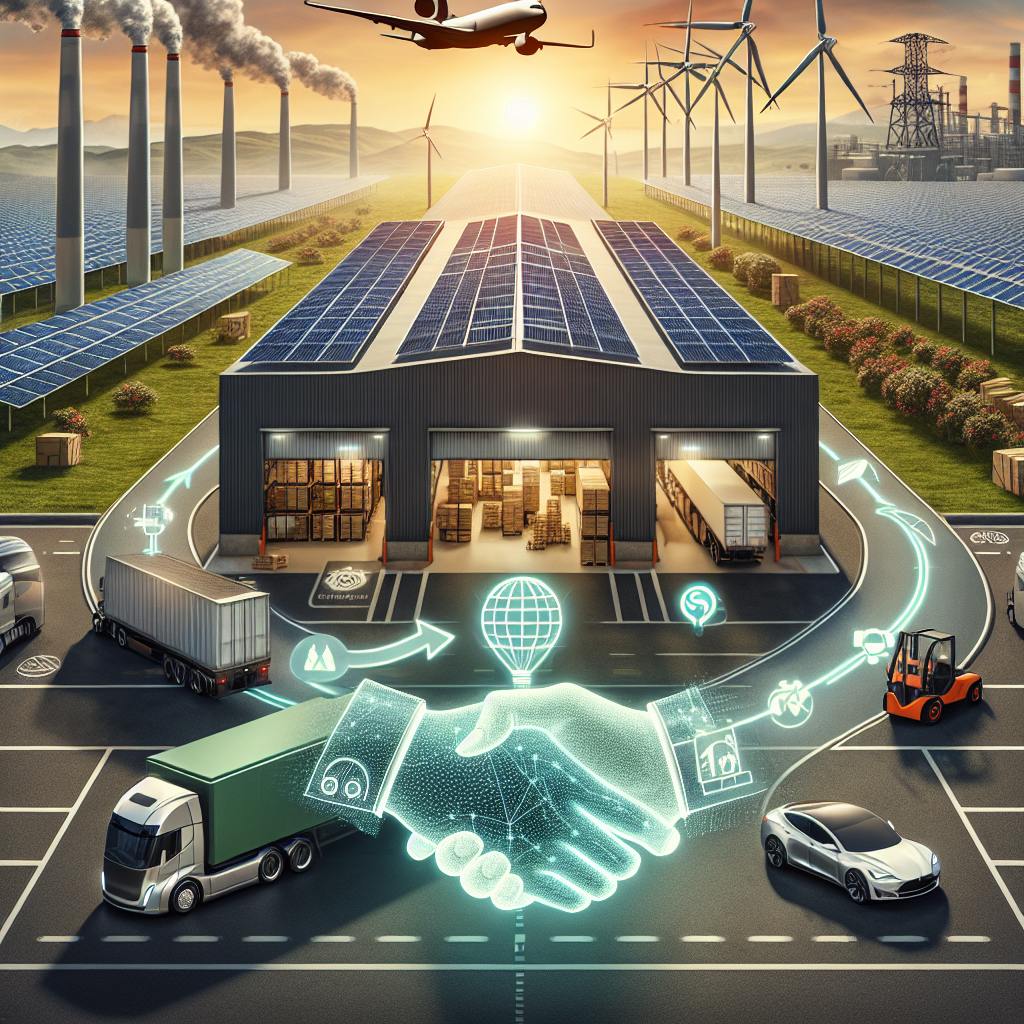 Explore the latest sustainable supply chain practices as companies integrate renewable energy, AI technology, and eco-conscious partnerships to reduce carbon footprints.
Explore the latest sustainable supply chain practices as companies integrate renewable energy, AI technology, and eco-conscious partnerships to reduce carbon footprints.
One trending development is the adoption of renewable energy sources to power supply chain operations. For instance, companies like Amazon and Walmart have committed to significant investments in solar and wind energy to fuel their logistics networks. This shift not only reduces their reliance on fossil fuels but also aligns with global sustainability goals.
Another trend is the integration of technology in optimizing transportation routes. Companies are leveraging AI-driven platforms to design efficient logistics networks that reduce fuel consumption and emissions. These innovative solutions are proving to be cost-effective while significantly enhancing environmental sustainability.
Moreover, collaborations with eco-conscious partners have become a focal point for many supply chain leaders. Companies are increasingly prioritizing vendors who observe sustainable practices, creating a ripple effect across the supply chain ecosystem. This approach not only provides a competitive edge but also fosters a holistic commitment to sustainability.
A recent example can be seen with Tesla, which has integrated a sustainable supply chain model in its operations. By sourcing raw materials from ethical and sustainable vendors and employing energy-efficient manufacturing processes, Tesla is setting a benchmark for others in the industry.
As these trends gain momentum, stakeholders in the supply chain domain are realizing the significant benefits of sustainability not only in terms of environmental impact but also in enhancing their brand image and customer loyalty. The shift towards a more sustainable supply chain is no longer just an option but a strategic necessity for companies aiming for long-term success.
The evolution of sustainable practices in supply chains is a topic of intense interest, and recent developments highlight the industry's commitment to a greener future. With continuous innovation and collaboration, the future of supply chains looks promising on the sustainability front.
Modernizing Logistics: The Impact of AI on Supply Chain Efficiency
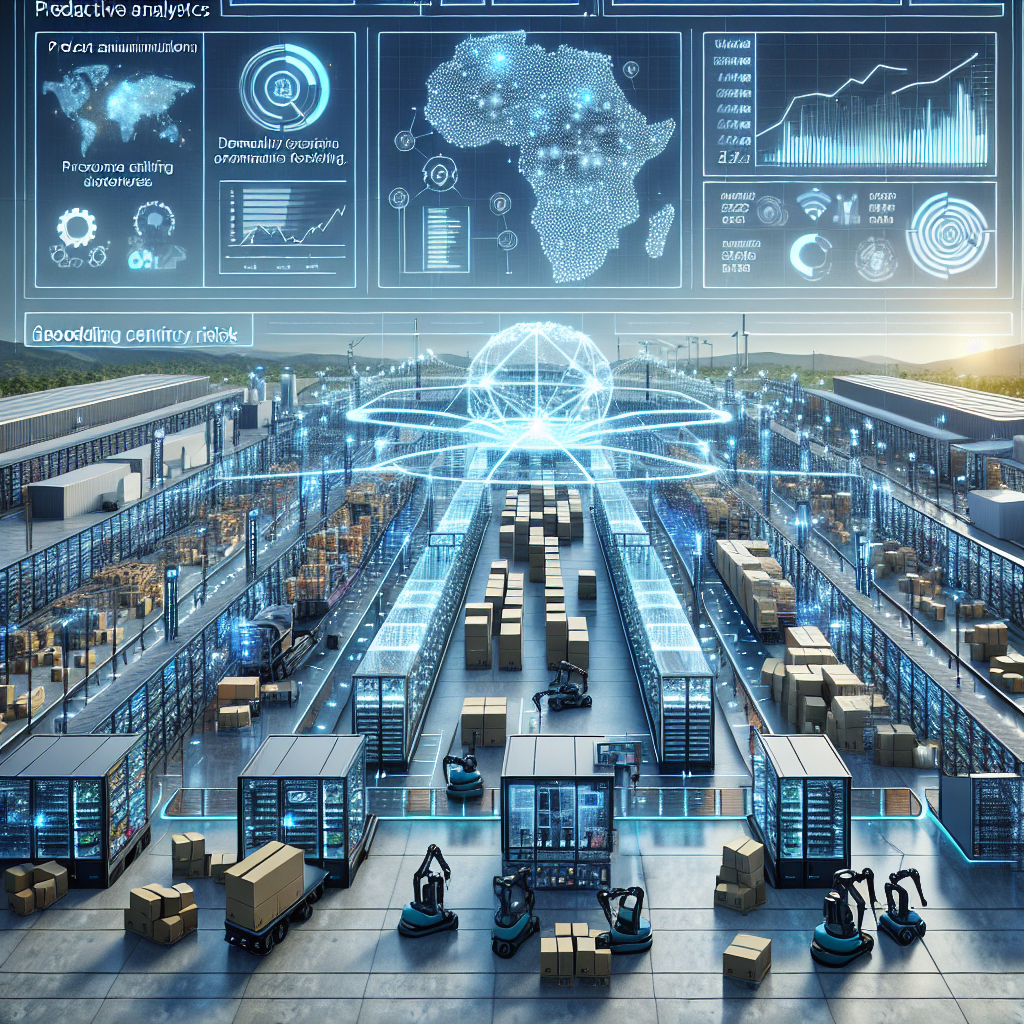 Explore how artificial intelligence (AI) is revolutionizing supply chains by enhancing operational efficiency, risk management, and automation. Discover real-world examples of AI's impact on logistics.
Explore how artificial intelligence (AI) is revolutionizing supply chains by enhancing operational efficiency, risk management, and automation. Discover real-world examples of AI's impact on logistics.
One of the most notable benefits of deploying AI in supply chains is the enhancement of operational efficiency. With the ability to process vast datasets, predictive analytics powered by AI offers valuable insights into demand forecasting, inventory management, and customer preferences. Companies are now equipped to make data-driven decisions, minimizing wastage and optimizing resource allocation. A prime example is Amazon's use of AI algorithms to streamline its inventory management, significantly reducing delivery times while maintaining cost-effectiveness.
Furthermore, AI-enhanced automation is a critical component of modern supply chains. Automation of repetitive tasks using robotics and machine learning minimizes human error and enhances productivity. As automation integrates with AI, tasks such as picking, sorting, and packing are performed with greater precision and speed. This technological synergy is evident in companies like DHL, which has leveraged AI to optimize warehouse operations, resulting in quicker dispatch and turnaround times.
AI is also playing a pivotal role in risk management and agility within supply chains. By evaluating patterns and predicting potential disruptions, AI empowers organizations to develop contingency strategies proactively. This has been particularly beneficial during unpredictable global events, where supply chain resilience is put to the test. Companies such as Unilever have successfully utilized AI to assess and mitigate risks, ensuring continuity even in challenging times.
While AI presents numerous benefits, its integration into supply chains is not without challenges. Concerns regarding data privacy and the need for significant investment in technology infrastructure can be hurdles for some organizations. However, the long-term value AI brings to supply chain management makes these initial concerns manageable for forward-thinking businesses.
In conclusion, AI is undeniably revolutionizing the supply chain industry by driving efficiency, accuracy, and adaptability. As more businesses harness AI's capabilities, the future of supply chain management promises to be more innovative and resilient than ever before.
The Impact of AI on Modern Supply Chain Management: Recent Developments
 Explore the latest developments in AI's impact on supply chain management, highlighting warehouse efficiency, predictive analytics, and risk management with real-life success stories.
Explore the latest developments in AI's impact on supply chain management, highlighting warehouse efficiency, predictive analytics, and risk management with real-life success stories.
In recent years, the intersection of artificial intelligence (AI) and supply chain management has become increasingly relevant as businesses seek to optimize their operations amidst growing complexities. Today, AI's role in modernizing supply chain management is undeniable, with a surging interest in AI-driven solutions reshaping the industry landscape.
A significant development over the past few days is the announcement by various leading logistics companies to integrate machine learning algorithms to improve warehouse efficiency. These algorithms analyze data in real time, enabling better decision-making around storage and goods retrieval. This approach not only enhances productivity but also reduces errors, benefiting both the businesses and their customers.
AI's application in predictive analytics is another trending topic. Businesses are leveraging AI models to predict demand fluctuations, which helps in maintaining optimal inventory levels. Such foresight can prevent stockouts and reduce excessive inventory costs. A notable success story comes from a major retail chain that recently implemented AI-based predictive models, which led to a 30% reduction in carrying costs.
Supply chain visibility has also seen improvements through AI. Advanced AI solutions are now employed to track shipments more accurately and provide real-time updates to stakeholders. This not only boosts transparency but also fosters trust with clients. Given the global scale and complexity of supply chains, AI's ability to dissect and comprehend immense datasets is crucial for sustaining competitive advantage.
Moreover, AI is proving its mettle in risk management within supply chains. By analyzing historical data, AI can forecast potential disruptions caused by factors such as extreme weather or geopolitical tensions. For instance, a recent case saw a leading electronics manufacturer mitigate adverse effects during a supply blackout by pre-emptively adjusting their supply routes using an AI-powered risk assessment tool.
These advancements underscore AI's transformative impact on supply chain management. As companies continue to innovate, the reliance on AI technologies is expected to grow, leading to more streamlined and efficient supply chain operations.
Navigating the Complexities of Supply Chain Resilience Amid Global Disruptions
 Explore how companies are navigating supply chain resilience amid global disruptions, with insights into risk management strategies and technology integration.
Explore how companies are navigating supply chain resilience amid global disruptions, with insights into risk management strategies and technology integration.
Recent events, including unexpected geopolitical confrontations and the ongoing challenges posed by the pandemic, have illustrated how fragile supply chains can be. The ripple effect of these disturbances has forced companies to reassess their strategies, emphasizing the need for robust risk management systems.
One of the primary methods organizations are employing to enhance resilience is diversifying their supplier base. By reducing reliance on a single source or region, companies are better positioned to withstand disruptions. This strategy not only minimizes risks but also encourages competitive pricing and innovation from suppliers.
Moreover, the integration of advanced technologies is providing firms with invaluable insights. Tools that enhance supply chain visibility, such as IoT sensors and blockchain, are enabling real-time tracking and transparency. These technologies allow businesses to respond promptly to disruptions, adjust production schedules, and communicate more effectively with partners.
Logistics companies are also innovating. Some are adopting asset-light models, leveraging third-party logistics providers to manage warehousing and transportation. This flexibility allows for quick adaptation to changes in demand and supply levels, mitigating potential bottlenecks.
An excellent example of achieving supply chain resilience can be found with a leading electronics manufacturer that, after suffering a major setback due to part shortages, revamped its entire supply protocol. By integrating AI-driven predictive analytics, they could foresee potential risks and adjust their sourcing strategies proactively, minimizing downtime.
As global economies gradually recover and stabilize, the emphasis on supply chain resilience will remain essential. Organizations that prioritize flexibility, diversify their supply networks, and leverage technology will be the ones to thrive in this unpredictable environment.
Adapting to Supply Chain Disruptions: Lessons from Recent Challenges
 Explore the latest trends in supply chain management, focusing on resilience and adaptability in the face of disruptions. Learn about diversified logistics strategies, enhanced inventory management, and the role of technology in ensuring supply chain sustainability.
Explore the latest trends in supply chain management, focusing on resilience and adaptability in the face of disruptions. Learn about diversified logistics strategies, enhanced inventory management, and the role of technology in ensuring supply chain sustainability.
One trend that emerged in the past few days is the increasing adoption of flexible logistics strategies. Companies are shifting towards more adaptable supply chain models, which involves diversifying suppliers and transportation routes. By doing so, they can hedge against unforeseen disruptions that can delay shipments or increase costs.
A prime example can be seen in how large retailers in the United States are responding to these challenges. They are investing heavily in technology to gain real-time insights into their supply chain operations. This includes using advanced data analytics tools to predict potential disruptions and developing contingency plans that are quickly deployable.
Moreover, inventory management has received a significant overhaul as a response to supply chain issues. Organizations are now practicing a more balanced approach between just-in-time and just-in-case inventory models. This hybrid approach allows them to be more flexible, maintaining adequate stock levels without incurring excessive costs.
The trend of collaboration is also gaining traction in the industry. Businesses are partnering with logistics experts and using shared resources to improve efficiency and resilience. This collaborative approach facilitates the sharing of information and best practices, which is crucial in managing and mitigating risks effectively.
Finally, digital transformation remains at the forefront of supply chain innovation. Embracing technologies like blockchain for enhanced transparency, as well as AI and IoT for predictive analytics, is not just about staying competitive—it’s about ensuring supply chain sustainability in the face of future uncertainties.
As supply chain dynamics continue to evolve, it is imperative for companies to remain vigilant and proactive. Staying informed on the latest trends and fostering a culture of adaptability will be vital in overcoming the challenges of today and tomorrow.
The Impact of Green Logistics on Modern Supply Chains
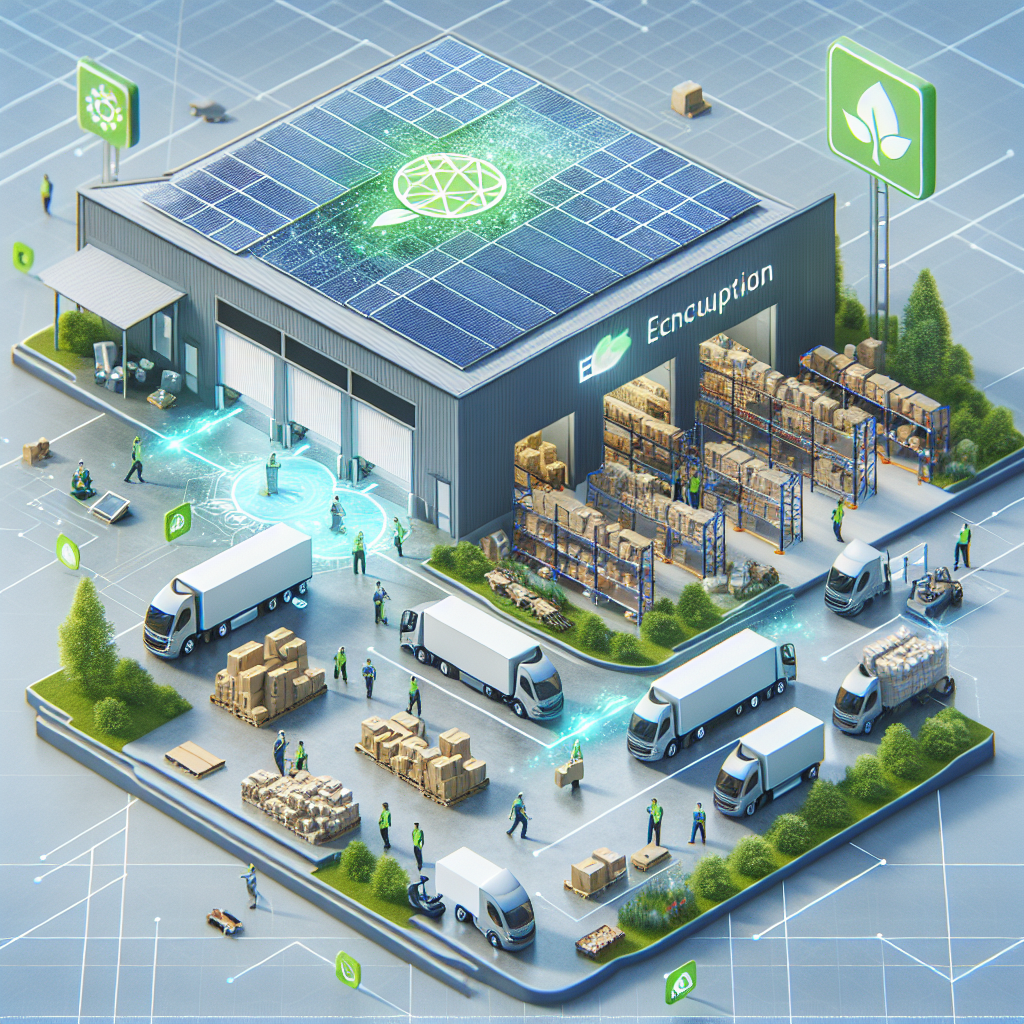 Explore the impact of green logistics on modern supply chains, focusing on sustainable practices and regulatory influences shaping the industry.
Explore the impact of green logistics on modern supply chains, focusing on sustainable practices and regulatory influences shaping the industry.
One of the driving forces behind this shift is the increasing awareness of carbon footprints associated with supply chain processes. By optimizing routes, enhancing fuel efficiency, and investing in alternative energy sources, businesses aim to reduce their environmental impact while maintaining operational efficiency. For instance, companies like DHL and UPS have made significant strides in decreasing emissions through the use of electric vehicles and green warehouses.
Furthermore, consumer expectations have evolved dramatically. Eco-conscious buyers are now more likely to support brands that actively engage in sustainable practices. This pressure has led many organizations to adopt transparent supply chain practices, ensuring that every step of the process aligns with green logistics principles. Brands like Patagonia and IKEA have set benchmarks by implementing innovative strategies such as recyclable packaging and sustainable sourcing.
Another aspect influencing the rise of green logistics is regulatory pressure. Governments worldwide are implementing stringent regulations aimed at reducing industrial emissions. Complying with these regulations not only aids in preserving the environment but also enhances a company's reputation. The U.S. Environmental Protection Agency (EPA), for instance, has introduced programs that incentivize organizations to adopt clean energy initiatives within their logistics operations.
Despite the clear benefits, transitioning to green logistics presents challenges. Initial investments in new technologies or infrastructure improvements can be substantial. However, the long-term cost savings from energy efficiency and waste reduction can outweigh the initial expenses. Companies like Tesla have demonstrated that innovation in green technology can be a lucrative endeavor, paving the way for other industries to follow suit.
Moreover, technological advancements play a crucial role in this evolution. The development of smart logistics solutions, such as AI-driven analytics and IoT-enabled sensors, allows companies to monitor and optimize their operations in real-time, ensuring minimal environmental impact.
Incorporating green logistics into supply chains is not just an ethical choice but a strategic one that promises long-term benefits for both businesses and the planet. As the movement gains momentum, it is essential for companies to keep pace with these trends and commit to sustainable practices.
Navigating the Challenges in Global Supply Chains
 Explore the current challenges faced by global supply chains, focusing on logistics bottlenecks, geopolitical impacts, and the application of advanced technologies to enhance efficiency and resilience.
Explore the current challenges faced by global supply chains, focusing on logistics bottlenecks, geopolitical impacts, and the application of advanced technologies to enhance efficiency and resilience.
One of the most immediate hurdles is the logistics bottleneck observed in major ports around the world. These congestions have been linked to labor shortages and outdated port infrastructure. The situation escalated during the pandemic when lockdown measures limited workforce availability and operations. Companies are now investing heavily in technology to enhance logistics management systems, providing real-time insights and more accurate forecasting to mitigate such future setbacks.
A case in point is when a leading electronics company faced production delays due to port congestion but managed to pivot effectively by utilizing advanced predictive analytics. This technology allowed them to reroute shipments and optimize inventory management, minimizing potential losses.
Another substantial issue is the rising geopolitical tensions that can skew trade relations and policies. Several industries have encountered sudden supply chain disruptions due to political instability and tariff impositions. Businesses are now leveraging diplomatic engagements and diversifying their supplier base to cushion the impact of abrupt regulatory changes.
Technology is also playing a pivotal role in addressing supply chain challenges. The development and integration of AI, IoT, and blockchain technologies are proving transformative. With real-time tracking facilitated by IoT devices, companies have improved visibility into their supply chains, allowing for quicker problem-solving processes. Blockchain, on the other hand, ensures transparency and security in transactions, building greater trust among supply chain partners.
In the evolving landscape of global supply chains, companies must maintain agility and adaptability. Investing in innovative supply chain technologies and fostering resilient relationships with both new and existing partners will drive future success. As the landscape continues to change, only businesses that remain proactive and adaptable will thrive.
The Rise of Alternative Energy Resources in Supply Chain Management
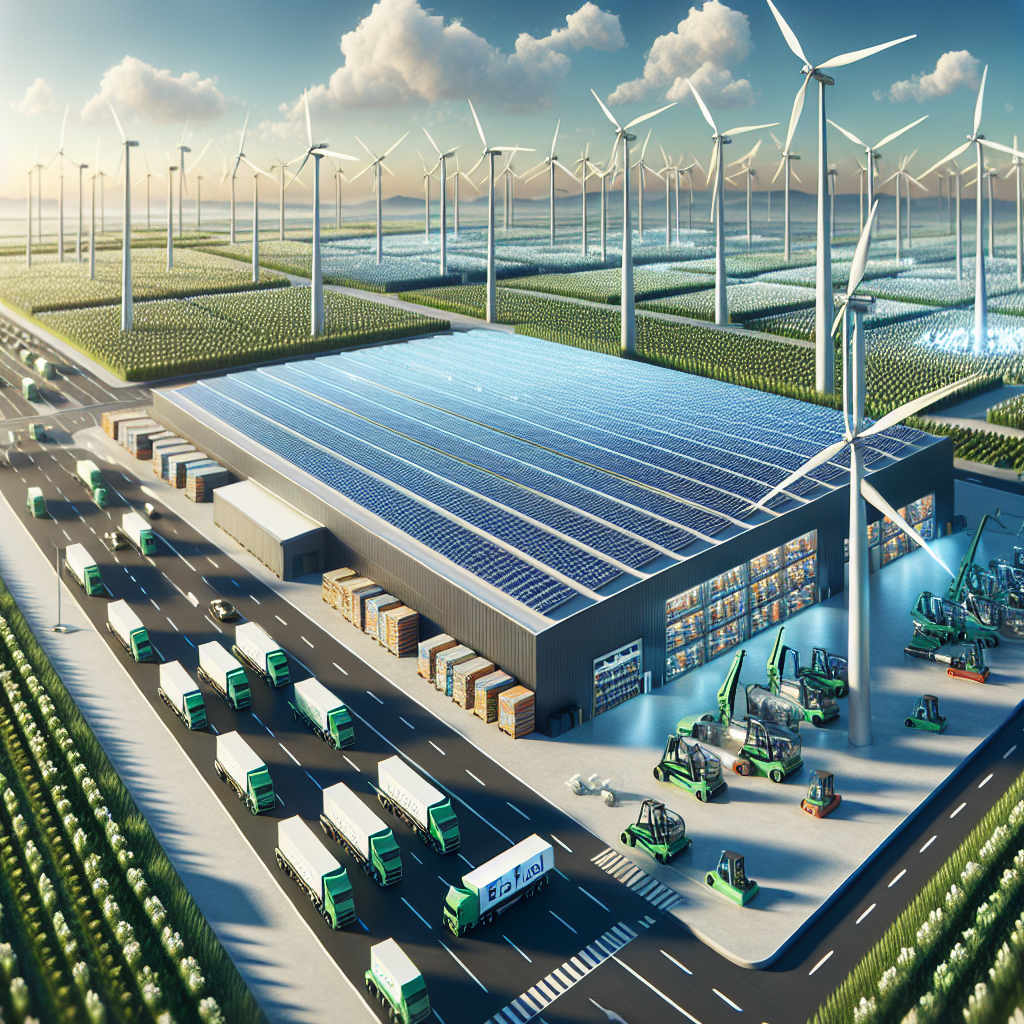 Explore how alternative energy resources are transforming supply chain management in terms of sustainability and cost-efficiency.
Explore how alternative energy resources are transforming supply chain management in terms of sustainability and cost-efficiency.
Recently, industry giants are opting for solar energy panels to power their distribution centers. This not only reduces their carbon footprint but also ensures energy cost savings in the long run. Companies like Amazon and Walmart are pioneering this shift by installing large solar farms to support their warehouse operations.
Moreover, wind energy is gaining traction as a complementary energy source. Logistics hubs in coastal areas are particularly well-poised to harness this resource. Wind energy contributes to grid stability, ensuring that supply chains remain resilient even during peak demand times.
Biofuels are another fascinating development. Shipping companies are investing in biofuel technology to transition their fleets from reliance on diesel. This is not only a move towards sustainability but also a strategy to cope with unpredictable fossil fuel prices. By 2025, defensive strategies employing biofuels could significantly reduce operational costs and enhance sustainability metrics across the industry.
The adoption of these renewable resources is reshaping the entire supply chain. From procurement to last-mile delivery, each step is being optimized to ensure efficiency and reduce environmental impact.
These practices are setting higher standards. Businesses that fail to adapt might find themselves grappling with increased scrutiny and potential regulatory challenges. The shift towards renewable energy sources is not just an operational enhancement—it's a reflection of brand ethos where sustainability and economic viability intersect.
Incorporating alternative energy in supply chains is exemplary, with case studies from top firms showing a favorable return on investment. The advancements in this field can no longer be viewed as optional; they are imperative for achieving a competitive edge.
How Self-Driving Trucks Could Disrupt Trucker Lifestyles And The Trucking Subculture
Autonomous trucks are revolutionizing the freight industry, with significant technological advancements and investments dedicated to their development. Some forecasters even predict that truck driving will be among the first major industries to be targeted by AI-driven automation. However, it is unlikely that robotic trucks will completely decimate the trucking profession in one sudden phase transition.
This innovation has created new opportunities for the trucking industry, with autonomous trucks being employed on specific routes and under certain conditions. As a result, the industry will continue to require an increased number of truck drivers, especially as freight volumes grow over time. While autonomous trucks may not eliminate the need for human drivers, they have the potential to address some of the challenges faced by the industry, such as recruiting and retaining drivers, particularly in long-haul trucking.
One aspect that may be impacted by the introduction of autonomous trucks is the trucker culture and lifestyle. Trucking is not just a job, but a subculture that has developed its own unique sense of identity, rituals, and camaraderie. The advent of self-driving trucks could disrupt these established norms and traditions.
Traditionally, truckers spend long hours on the road, navigating vast distances and coping with the solitude and isolation that comes with the job. They rely on their driving skills, expertise, and deep knowledge of the roadways to get the job done. The sense of independence and freedom that trucking offers has shaped the trucker lifestyle, which includes the iconic image of a trucker behind the wheel, exploring the open road.
With the introduction of autonomous trucks, the role of the truck driver is likely to change. While drivers may still be needed for certain aspects of the journey, such as navigating city streets or addressing unexpected situations, autonomous technology will handle the majority of the driving tasks. This shift may reduce the sense of control and agency that truckers have enjoyed for years, potentially impacting their sense of job satisfaction and fulfillment.
Moreover, the introduction of autonomous technology could alter the social dynamics within the trucking community. Truckers often form close-knit networks, sharing stories, advice, and support with their fellow drivers at truck stops or on CB radios. The sense of camaraderie and solidarity is a vital part of the trucker subculture. If autonomous trucks become more prevalent, the traditional trucker community may experience changes as face-to-face interactions are reduced, and the reliance on technology for communication increases.
Additionally, the potential reduction of job opportunities for truck drivers due to the adoption of autonomous trucks could create economic challenges for individuals and communities that heavily rely on the trucking industry. The trucker lifestyle and culture are deeply connected to economic factors, and any disruption in the availability of trucking jobs could have a significant impact on both individual truckers and the communities they support.
It is important to note that the impact on trucker culture and the trucking subculture will not be uniform or immediate. The transition to autonomous trucks will likely occur gradually, providing time for adaptations and adjustments to be made within the industry and among truckers themselves. Moreover, human truck drivers will still play a role in the operation and maintenance of autonomous trucks, ensuring that their expertise and experience remain valuable assets.
In conclusion, while autonomous trucks have the potential to disrupt the trucker lifestyle and trucking subculture, the impact will depend on the rate of adoption and the extent to which autonomous technology replaces human drivers. The introduction of self-driving trucks may alter aspects of trucker culture such as the sense of independence and the social dynamics within the trucking community. However, the full effects will only become clear as the industry continues to evolve, and truckers adapt to the changes brought about by technological[1][2]
Personal Shopper Drones and Last Mile Delivery
Personal shopper drones are an exciting development in the field of last-mile delivery. These drones have the potential to revolutionize the way goods are delivered to consumers, offering a fast and convenient solution to the challenges of final-mile logistics.
The concept of personal shopper drones involves the use of unmanned aerial vehicles (UAVs) to transport goods directly to customers' doorsteps. These drones are equipped with advanced navigation and automation technologies that allow them to safely navigate through urban areas and deliver packages with precision and efficiency.
One of the key advantages of personal shopper drones is their ability to bypass traditional delivery routes and traffic congestion. By taking to the skies, they can avoid the challenges of navigating crowded streets and deliver goods directly to consumers in a fraction of the time it would take for a traditional delivery vehicle. This not only improves delivery speed but also reduces the carbon footprint associated with last-mile transportation.
Personal shopper drones also offer a level of convenience that is unparalleled in traditional delivery methods. With drones, consumers can receive their goods at their doorstep without the need to be present or interact with delivery personnel. This is particularly beneficial for busy individuals who may not have the time to wait for deliveries or prefer contactless transactions.
However, there are several limitations that currently restrict the potential of personal shopper drones in last-mile delivery. One of the main challenges is regulatory compliance. The operation of drones is subject to strict regulations and airspace restrictions in many countries, making it difficult to fully exploit their capabilities for commercial deliveries.
Another limitation is the weight and payload capacity of drones. While advancements in technology have led to the development of drones with increased payload capacity, the ability to carry larger and heavier packages remains a challenge. This restricts the types of goods that can be delivered by drones and may limit their applicability to small and lightweight items.
Additionally, the range and flight time of personal shopper drones are currently limited. Most commercially available drones have a relatively short flight time and range, which may restrict their use to localized delivery operations. This means that drones may be more suitable for deliveries in densely populated urban areas rather than remote or rural locations. This is primarily due to the higher concentration of potential customers in urban areas compared to less populated rural areas. In densely populated urban areas, delivery routes for drones can be more optimized and efficient, as there are shorter distances between delivery points and a greater number of customers in closer proximity.
Moreover, urban areas often have better infrastructure in terms of communication networks and landing areas, which are crucial for safe and reliable drone deliveries. Drones depend on the availability of strong and stable internet connectivity to ensure accuracy in navigation and real-time tracking. Additionally, urban areas tend to have designated landing spots, such as rooftops or open spaces, where drones can safely land and deliver packages.
In contrast, remote or rural locations usually have longer distances between delivery points, making drone deliveries less time and energy-efficient. The lack of proper communication infrastructure and landing spots further complicates the operations in these areas. Additionally, remote locations might have challenging environmental conditions, such as strong winds or rough terrain, which can pose risks to the stability and safety of the drones.
It is important to note that while drones can be more convenient for urban deliveries, there are still several regulatory, safety, and privacy concerns that need to be addressed before widespread drone deliveries can take place. Nonetheless, the potential for drones in densely populated urban areas is promising and can revolutionize the delivery industry by providing faster and more accessible services.
Despite these limitations, there is great potential for personal shopper drones to transform last-mile delivery. As technology continues to advance and regulations evolve, we can expect to see further improvements in drone capabilities, including increased payload capacity, extended range, and improved flight time.
In conclusion, personal shopper drones have the potential to revolutionize last-mile delivery by offering fast, convenient, and eco-friendly solutions. While there are limitations that currently restrict their widespread adoption, advancements in technology and regulatory frameworks are likely to pave the way for a future where drones deliver directly to consumers' doorsteps. [1]
Crazy Warehousing Robots - A Look At Some Of The Wackiest And Most Innovative Robots Being Used In Warehouses Today
Over the years, robots have become an essential part of streamlining operations and increasing efficiency in different industries. While robots have been there for many decades, they have never been as advanced as they are today. Unlike traditional robots, modern robots go beyond the typical automated machines we are accustomed to seeing. They are being referred to as "crazy warehousing robots" for their wacky and innovative features that make them stand out in the industry.
One such example is a pair of robots that resemble goofy green footstools from the future. Their round eyes and satisfied grins are rendered with light-emitting diodes. This gives them a quirky and unique appearance. Introduced in November 2022, these robots can pick individual products from storage cubbies and place them into larger plastic bins. This advancement brings them closer to achieving human-like dexterity, which has long been a holy grail in the field of robotics.
These crazy warehousing robots also have the ability to navigate the warehouse environment. Around 12,000 Pegasus robots can be seen in a warehouse in Reading, Massachusetts, zipping around the centre of the room. They are the size of lawn-mower-scale models. They drop packages down holes in the floor that lead to the loading docks. Once they have completed this task, they return to a designated parking spot on the floor, ready for their next assignment.
What sets these robots apart is the incorporation of lidar sensors on their heads, resembling tiny hats. The lidar sensors allow the robots to scan nearby objects and people in 3D, ensuring safe and efficient navigation through the warehouse. While this is an important component, it is not the only thing that makes them fascinating. On top of this ability, these robots also have a touch of whimsy. They might surprise observers sometimes by playing chipper tunes, flashing lights, or morphing their eyes into heart shapes. These playful gestures add a human-like element to their otherwise mechanical nature.
The implications of these crazy warehousing robots go beyond mere entertainment value. They have the potential to bring about a significant shift in the balance between automation and human labor. These robots can augment human workers and remove bottlenecks in the automation of manual work by performing tasks that were previously considered too complex for robots, such as dexterously picking individual items. This breakthrough could revolutionize the way warehouses operate for the better, leading to increased productivity and efficiency. Introducing automated robot systems into warehouses could also change the way these facilities operate. Incorporating advanced robotics technology into warehouse operations can witness a significant boost in productivity and efficiency. With this, the tasks that were traditionally time-consuming and labor-intensive can be automated, resulting in streamlined operations and reduced human error.
Warehouses can optimize their inventory management, order fulfillment, and logistics processes with the help of automated robot systems. These robots can efficiently organize and track inventory, reducing the chances of misplaced or lost items. Furthermore, automating these tasks can help warehouses save time and resources, ultimately improving overall productivity.
Additionally, these robots possess the ability to precisely locate and move products within the warehouse, eliminating the need for manual picking and sorting. This automation results in faster order fulfillment and a more efficient distribution process. Moreover, the robots can adapt to changes in order volume or seasons, enabling warehouses to scale their operations accordingly and handle peak periods with ease.
Incorporating automated robot systems can also enhance workplace safety by minimizing the risks associated with heavy lifting and repetitive movements. This technology can alleviate the physical strain on warehouse employees and promote a safer working environment.
Ultimately, this breakthrough has the potential to revolutionize the warehouse industry by shifting from traditional labor-intensive methods to a highly advanced and efficient system. Increasing productivity, optimizing inventory management, and enhancing workplace safety enables warehouses to stay ahead in a competitive market and meet the growing demands of e-commerce and retail sectors.
Overall, these wacky and innovative robots showcased in the world of warehousing are pushing the boundaries of what was once considered feasible in the field of automation. Their unique features and capabilities not only make them stand out visually but also demonstrate the tremendous strides being made in robotics. As technology continues to advance, we can expect to see even more astonishing and quirky robots being deployed in warehouses, transforming the way goods are handled and creating a more.
How 3D Printing is Transforming Supply Chain Processes
More than ever, 3D printing, also known as additive manufacturing, has emerged as a disruptive technology with the potential to revolutionize supply chain processes across various industries. This technology, apart from different application areas in supply chain is able to alter other industries for the better. In the supply chain sector, this innovative technology improves manufacturing methods offering numerous advantages over traditional manufacturing techniques, particularly in terms of flexibility, speed, and cost-effectiveness.
First, the leading way in which 3D printing is transforming supply chain processes is by making them independent from consumer demand. Unlike in the traditional methods where companies needed to rely on forecasting consumer demand and manufacturing parts in large batches to achieve economies of scale, 3D printing enables companies to manufacture parts on-demand, eliminating the need for minimum order batches and reducing the risk of excess inventory. This not only leads to cost savings but also enables companies to respond quickly to changing market demands.
Secondly, 3D printing on the supply chain is capable of bringing production closer to the final point of use. 3D printing reduces the need for extensive transportation and storage of goods by enabling localized manufacturing. As a result, it, leads to shorter delivery times and lower logistics costs. Therefore, companies can also take advantage of this technology to create a more flexible approach by producing small customized batches. With quick turnaround time, businesses can then meet the specific needs of customers while minimizing waste.
3D printing can also transform various aspects of the supply chain, including warehousing and distribution. With the digitalization of warehouses, companies can store digital designs as opposed to physical inventory. This significantly reduces storage space requirements. This not only frees up valuable warehouse space but also enables companies to easily customize products and quickly adapt to changes in demand.
Furthermore, 3D printing has the ability to enhance business intelligence in the supply chain. It does so through integrating it into supply chain processes, which enables companies to gather real-time data on production, inventory, and customer preferences. This data can help optimize production schedules, improve inventory management, and gain valuable insights into customer behavior, ultimately leading to more informed decision-making.
Adopting 3D printing in supply chain processes can also promote sustainability and environmental responsibility. Unlike the traditional manufacturing methods that often result in significant waste due to the need for mass production and excess inventory, 3D printing only uses the necessary materials to create a specific product, minimizing waste and reducing the carbon footprint.
From now into the future, the transformational potential of 3D printing in supply chain processes will be vast. With the continued evolution of this technology, we may witness a convergence of design, production, and distribution into one seamless supply chain function, with greater customer involvement throughout the entire process. This level of integration and customization has the potential to revolutionize the way products are manufactured and delivered, opening up new opportunities for businesses to innovate and thrive in an increasingly competitive global market.
In conclusion, 3D printing is transforming supply chain processes by enabling companies to become more independent from consumer demand, bringing production closer to the point of use, and offering greater flexibility and customization. This disruptive technology has the potential to revolutionize various aspects of the supply chain, from logistics and warehousing to business intelligence and sustainability. As companies continue to embrace and integrate 3D printing into their supply chain strategies, we can expect to witness a paradigm shift in how products are manufactured and distributed, ultimately leading to more efficient, agile, and customer-centric supply chains.
Industry 4.0 is bringing about Supply Chain 4.0. Are you ready?
 Transacting business in the supply chain generally means communicating orders via EDI formatted files or some other equally rigid set of rules. The reasons are easy to understand; order times are critical and specifications for orders are complex so their formats need to adhere to formats that can be instantly read by computerized systems.
Transacting business in the supply chain generally means communicating orders via EDI formatted files or some other equally rigid set of rules. The reasons are easy to understand; order times are critical and specifications for orders are complex so their formats need to adhere to formats that can be instantly read by computerized systems.
EDI requirements may be rigid but they change frequently so there’s some reason to believe that there is in fact, flexibility within the order process. But getting the details wrong causes errors and costs money. How will this tight connection fare in the age of what’s called ‘Industry 4.0’ as new technologies are brought into the mix? Is it possible that the long-standing EDI format will be replaced by directly connected machines (IoT) that avoid the details of creating and processing orders? Or will the deeply embedded format keep business at a slower pace than might be possible if things changed?
Industry 4.0
Internet of Things (IoT) is impacting manufacturing, shipping, warehousing, delivery, and even customer support by adding smart devices to things that have traditionally been, well… dumb. Dumb in the sense that they don’t communicate or have any way to sense their surroundings. That’s changing rapidly as we approach the widely touted 50 billion IoT devices expected to populate the earth by 2020. Whether any particular company wants to move toward these automated pipelines is as moot as those who declared they were not abiding by Walmart’s demand to implement EDI years ago.
Manufacturing facilities around the globe are adding smarts to their machinery or replacing old machines with newer and smarter ones that can go beyond the basics of their intended functions. They are attached wirelessly directly to their company’s management and ERP systems and communicate their current status. They take instructions about manufacturing conditions to adjust their speed and can even sense variations in the materials they work with and adjust their actions to create products that meet required specifications.
The data passed between those machines and the systems that control them amount to magnitudes of data that never existed meaning that traditional manufacturing facilities that operated manually and on a completely analog basis are becoming digital factories. The data itself presents both issues and opportunities for every point along the supply chain because it’s now possible for the end customer to be aware of the status of the product they expect to purchase, and for the manufacturing machine to know how many units it needs to build to meet demand.
Flexibility stretched
Every participant in the supply chain is being armed with more data than they have ever encountered. Their first challenge is to collect and store it; in itself a mundane IT task of managing storage and connectivity. But what is done with that accumulated data as it passes along the chain is what will define the next generation manufacturer, transport company, retailer, and even the end customer. Those that devote the time and resources to understanding, then imagining how Supply Chain 4.0 will look.
Walmart - The NEW Mandate
 It’s been a while since Walmart first insisted that its suppliers moved to its digital order process. Back then the prospect of using EDI rather than fax or phone to place orders seemed like a technological hurdle. And in fact it was a significant hurdle that plenty of suppliers bucked against. But today Walmart’s tactics have become accepted and electronic order processing is no longer the pariah it once was. Now the retailer is making another mandate to its suppliers. But this time it’s not about what but where.
It’s been a while since Walmart first insisted that its suppliers moved to its digital order process. Back then the prospect of using EDI rather than fax or phone to place orders seemed like a technological hurdle. And in fact it was a significant hurdle that plenty of suppliers bucked against. But today Walmart’s tactics have become accepted and electronic order processing is no longer the pariah it once was. Now the retailer is making another mandate to its suppliers. But this time it’s not about what but where.
Amazon’s Web Services (AWS) has been the go-to supplier of cloud based software deployments and an overwhelming number of companies have put their online software there. It’s easy, reliable, and competitively priced. But now that Amazon is competing directly with Walmart for retail business Walmart doesn’t want the digital guts of its business hosted on a competitor’s site. That’s understandable, and in fact in 2014 the company moved its entire ecommerce presence to the cloud - and not Amazon’s cloud.
Our colleague Steven J. Vaughan-Nichols explains the move and strategy here.
So where’s the mandate?
It isn’t enough that Walmart hosts its own data away from AWS. The retailer doesn’t want its suppliers hosting its data and the transactions they process on its competitor’s cloud either. The most recent mandate instructs suppliers to move their systems off AWS. They’re apparently fine with alternate cloud vendors like Microsoft Azure who are not direct competitors, but Amazon is a no-no.
To be clear, the mandate (for now) is directed at tech providers. So product suppliers who host their own systems on AWS may not be affected. But the move may turn out to indirectly impact product suppliers if their EDI service providers host their applications and data on AWS.
The ripple effect
Amazon has done a great job of delivering cloud computing facilities that make it easy for companies to deploy their software services. In fact it may be the default choice for smaller EDI service providers because they can concentrate on developing their systems and delivering high quality customer support while leaving the heavy lifting of server farms and data centers to Amazon.
If your EDI provider has received a mandate letter from Walmart to shift its cloud hosting services you can bet they are scrambling to meet whatever deadlines are being required. Their revenue is reliant on delivering their customers’ transactions (your transactions) to and from Walmart and every other trading partner you deal with. And because of the depth and breadth of Walmart’s vendor base nearly every EDI service provider has connections to Walmart.
Be proactive
Don’t know if you will be affected? Ask your EDI service provider where their applications are hosted and how they are responding to Walmart’s mandate. Either your provider will need to change or you will need to change your provider if you want to keep your business relationship with Walmart.
Your EDI App
 Moving EDI data around the globe is old hat to most of the folks reading this ec-bp newsletter. Managing the connections and translations can get complex and picky when it comes to the details of the files and the changes that need to be incorporated into translators to make processes flow properly. For most EDI practitioners, their roles are fairly well defined and fit well with established concepts. But as mobile devices take over I think the line between what is EDI and what is associated with end user interaction is changing.
Moving EDI data around the globe is old hat to most of the folks reading this ec-bp newsletter. Managing the connections and translations can get complex and picky when it comes to the details of the files and the changes that need to be incorporated into translators to make processes flow properly. For most EDI practitioners, their roles are fairly well defined and fit well with established concepts. But as mobile devices take over I think the line between what is EDI and what is associated with end user interaction is changing.
The majority of enterprise workers carry some kind of smart phone or tablet with them. That means that folks have at least the capacity to access their data and applications if it's important to do so.
But fewer people that have mobile devices connect to their supply chain systems using these devices. It could be that they never found it necessary to do so, or that they don't want to be bothered with work issues while they are away. But I believe the issue has more to do with having the proper applications in place to easily and quickly connect to their systems. For most, I think the issue is the availability of the appropriate app.
But is there really a reason to extend access beyond the company firewall? If every transaction processes correctly, and all systems work as they should, there is little reason to access these systems. But the reality is that there are always issues to be managed.
As mobile apps become more commonplace, forward thinking EDI providers and the companies that use them are seeing the demand for these apps from their users. Even if the apps deliver low levels of functionality for status checking and minor management tasks, not having these extensions to their systems will eventually be seen as missing features.
Big Data from EDI Can Make Predictions
 EDI is a significant source of big data. Of course that's no shock to anyone dealing with data storage or a VAN bill, but when you consider the volume of transactions and the number or companies involved, it would seem that there is a wealth of data in those transactions. The data now covers (depending on the trading partners) every aspect of the order process, from initial P.O. to final payment, with plenty of status updates along the way. So, what can be learned from all the data? It turns out that when looked at as an aggregate and put through the right analytical processes, there's plenty to be learned - and predicted.
EDI is a significant source of big data. Of course that's no shock to anyone dealing with data storage or a VAN bill, but when you consider the volume of transactions and the number or companies involved, it would seem that there is a wealth of data in those transactions. The data now covers (depending on the trading partners) every aspect of the order process, from initial P.O. to final payment, with plenty of status updates along the way. So, what can be learned from all the data? It turns out that when looked at as an aggregate and put through the right analytical processes, there's plenty to be learned - and predicted. EDI software/service providers/VANs that act as collecting points for EDI data are in a great position to help leverage this data because all the transactions they transfer between trading partners pass through their servers. At some point these transactions are stored on their servers, and some of the providers maintain those transactions for historical purposes. The newest trend that these providers are offering is to leverage those transactions by applying business intelligence techniques to them. What emerges from these advanced calculations takes on many forms, but in general they paint a picture of what has happened, and what is likely to happen in the future.
Popular Articles
- Most read






